The modular design of traditional desktop computers, while theoretically allowing for complete configuration flexibility, in practice is subject to application and common sense limitations. Despite this, there is a de facto standard build on the market for various segments, for example, in high-end gaming computers. An example of such an assembly includes a GeForce x70, a junior Core i5, a budget motherboard, memory modules, a terabyte of disk space, a power supply and a spacious case.
This approach dominated for decades, with some changes in details. For example, with the advent of SSDs, disk capacity has increased and motherboards have become more functional. Ryzen processors and AMD graphics cards have also made changes in recent years, but the basic principle has remained the same.
Although relatively standard, the configurations are controversial due to differences in implementation. This is especially true for self-assembly or custom assemblies, where the buyer has latitude in choosing components. Different opinions may arise, for example, when choosing between one terabyte SSD and 2 TB HDD, which emphasizes an individual approach to configuration.
The Raskat Strike brand from the 3Logic Group is an example of the second type — a large distributor offering system units at the price of components. This creates competition with self-assembly, where the user can fine-tune the configuration. The capabilities of small assemblers include customization for the client, while large ones can save on wholesale prices.
The Raskat Strike brand offers different models, including gaming ones, with different video cards and processors. This review covers the Strike 520 model with an Intel Core i5-13400F processor and a GeForce RTX 4070 Ti video card, which represents a classic concept with a powerful video card and a budget processor.
Exterior
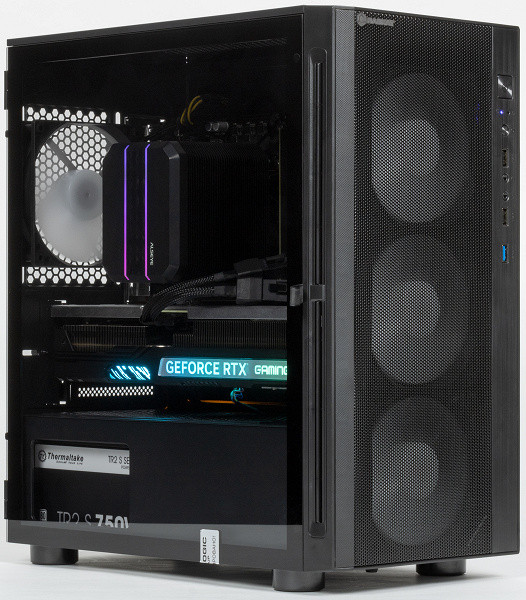
As we warned in advance, such computers do not offer unique solutions, because they are assembled in standard or similar cases. In this case, we are dealing with a regular tower, where the power supply is located at the bottom, intended for motherboards of microATX format and smaller. In keeping with trends, there are no externally accessible drive bays, and the front panel serves primarily for ventilation. The transparent side wall allows the installation of four illuminated fans, creating an effect similar to a Christmas tree. However, the backlight can be turned off while the fan speed remains constant, which can create a constant noise despite its uniformity. This may be convenient for gamers, but less acceptable for those who value silence during simple tasks such as web browsing.
The buttons and ports on the front panel are optimized for convenience when installing the system unit on the floor or in a table niche. The set of ports is quite standard, but, as is often the case in budget cases, only one USB 3.0 port and two USB 2.0 are provided. The lack of USB Type-C and other modern capabilities remains a general limitation in this model.
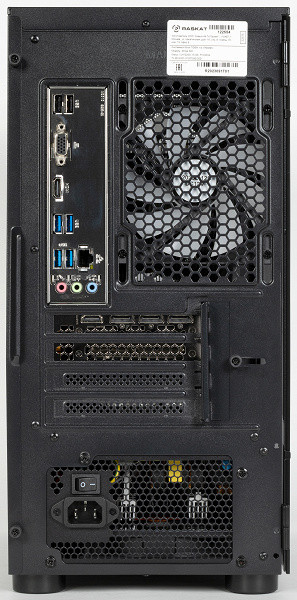
The lack of USB ports on the front of the computer is another aspect to note. Instead, there are four USB 3.0 (or USB 3.2 Gen1) and a pair of USB 2.0 on the rear panel, as well as three audio jacks and gigabit Ethernet. Video connectors, despite their presence, remain unused due to the selected processor, which even includes analog VGA. This can lead to confusion when making a purchase based on a photo alone if the buyer was expecting to plug in an old monitor and is faced with a lack of a suitable connector.
Another drawback is the lack of a front dust filter. Considering the active use of three fans for air intake, regular cleaning of the inside of the system unit becomes necessary, especially when placing the computer on the floor. While filters are present at the bottom and top, the lack of a front filter can be a misunderstanding in this configuration.
However, most complaints about the case are typical for inexpensive models. The savings associated with budget cases remain, which is likely to be an important consideration for three-quarters of buyers. Despite the noise of the fans at rest, they provide excellent ventilation, which is important when the system is working intensively. Some may not pay attention to this factor, since the noise becomes noticeable only when inactive.
Hardware configuration
The section on components becomes key, given that computers of this type are assembled from standard parts. Performance is usually clear without additional testing, and retail prices for components are readily available in stores, making it easier to evaluate the feasibility of a pre-assembled assembly compared to sourcing components yourself. Let's start with a traditional table.
| Raskat Strike 520 | |
|---|---|
| CPU | Intel Core i5-13400F |
| Motherboard | Gigabyte B760M H DDR4 |
| RAM | 2×DDR4 DIMM (up to 64 GB) |
| 2×Apacer AU16GGB32CSYBGH 32 GB DDR4-3200 | |
| Video subsystem | discrete graphics card up to Nvidia GeForce RTX 4070 Ti |
| Palit GeForce RTX 4070 Ti GamingPro OC | |
| Sound subsystem | Realtek ALC897 |
| Drives | 2×SSD M.2 2280 PCIe Gen4 x4 |
| 1×Adata Legend 800 1TB (PCIe Gen4 x4) | |
| 2×HDD/SSD 2.5″ (SATA600) | |
| 2×HDD 3.5″ (SATA600) | |
| Wired network | Realtek RTL8111H (up to 1 Gbps) |
| Wireless network | No |
| Bluetooth | No |
| Interfaces and ports on the top panel | 2×USB 2.0 |
| 1×USB 3.0 | |
| headphone output | |
| microphone input | |
| Interfaces and ports on the rear panel | 4×USB 3.0 |
| 2×USB 2.0 | |
| 1×VGA + 1×HDMI on motherboard (does not work with this processor installed) | |
| 1×RJ-45 | |
| 1×HDMI 2.1 (on video card) | |
| 3×DisplayPort 1.4 (on video card) | |
| 3 audio jacks | |
| power unit | 750 W |
| Dimensions and weight | 428×378×205 mm |
It is important to note that the configuration is “floating”, where the specifications indicate only the central and graphic processors, the amount of memory, SSD, and the presence or absence of a hard drive. Specific manufacturers of the motherboard, SSD and video card are not indicated. As a result, the computer you actually buy may contain components from different makes and models, but prices also fluctuate, which can compensate for the differences.
For example, our system had a Gigabyte B760M H DDR4 board installed, but the Gigabyte B760M DS3H DDR4 is more often found on sale. The retail price of these models varies, but compared to the overall cost of the system unit, the difference is insignificant. The more expensive DS3H has additional features such as 2.5 Gbps network, USB3 Gen2 Type-C port and four RAM slots. It would seem that the savings on such parts are insignificant, but ready-made system units are usually chosen by those who do not plan significant upgrades.
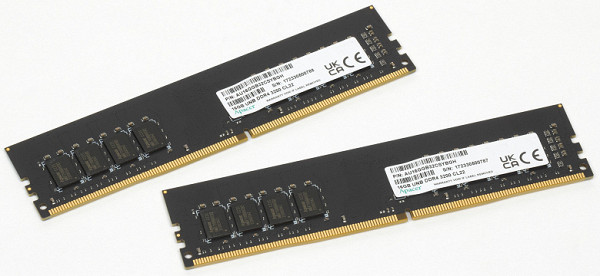
It is important to note that the configuration is “floating”, where the specifications indicate only the central and graphic processors, the amount of memory, SSD, and the presence or absence of a hard drive. It is noted that specific manufacturers of the motherboard, SSD and video card are not indicated, and prices for components may fluctuate. An example of this is the use of Gigabyte B760M H DDR4 and Gigabyte B760M DS3H DDR4 boards, which, although they have different characteristics, can be found in the package.
In the context of possible upgrades, it is emphasized that the memory capacity is initially 32 GB, which is likely to be relevant even by the time the computer begins to become obsolete. Gigabit Ethernet is also noted as a resilient and low-aging component. Power for the Core i5-13400F processor is rated as satisfactory, without the need to replace the board. It is very likely that the video card will become obsolete first, but this, according to the author, will not happen soon, given the power of the GeForce RTX 4070 Ti.
It is also emphasized that the final choice may depend on the individual preferences of the user, and perhaps higher-end full-size models will be preferable for those seeking maximum customization and advanced capabilities.

The same applies to SSDs: only the capacity is indicated, without mentioning a specific interface. In this case, we consider the Adata Legend 800 SSD, which uses a Silicon Motion SM2267XT controller (virtually supporting PCIe Gen4) and 144-layer Intel N38A QLC memory. It is noted that in the budget segment and in OEM solutions, QLC memory is becoming more common, and many users choose it, realizing the possible savings. The only problem noticed is the capacity. The author expresses a preference for a 2 TB SSD given the appetite for modern games, although the difference in cost compared to the overall cost of a gaming system unit may not be noticeable. It is important to note that the user may have to add additional drives in the future.
It also emphasizes the flexibility of «floating» configurations, which the assembler can easily change during production. It has been noticed that recently similar configurations with the tested system have practically disappeared from the market, and new ones offer a 2 TB SSD complete with 32 GB of RAM. The author expresses satisfaction with this, believing that a dedicated gaming PC should not require upgrading for a long time.
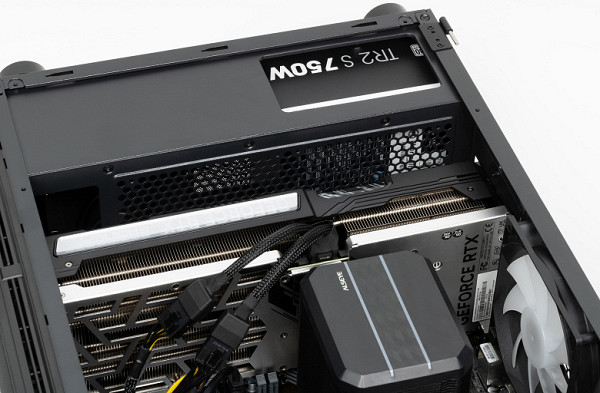
The Thermaltake TR2 S 750W power supply has excess power for this configuration, but its capabilities are limited by the presence of only two PCIe 2.0 (6+2) video card power connectors. This implies that the maximum graphics card that can be installed is the GeForce RTX 4070 Ti. The likelihood of upgrading to a more powerful graphics card appears to be slim, especially for off-the-shelf PC buyers, who often use a system to the point where upgrading is no longer worthwhile and purchasing a new computer seems a more attractive option.
Performance testing
In principle, this testing can be excluded, since, unlike “specialized” computers (such as compact or other non-standard form factors), the components in this segment are standard and well-known, no surprises are expected. In addition, the methodologies used, especially in the field of gaming tests, are outdated and will soon be replaced. Tests of such systems are used primarily to identify potential deficiencies, and the performance of the components is already known.
However, we decided to test the Core i5-13400F processor in a standard environment, including a top-end motherboard, a powerful power system, a liquid cooling system for the processor, 32 GB of DDR5 memory, etc. This will allow you to evaluate the processor's performance under more demanding conditions, such as those that may be encountered when using a high-spec system.
| Test | Raskat Strike 520 |
|---|---|
| Video conversion, points | 185.1 |
| MediaCoder x64 0.8.57, c | 66.93 |
| HandBrake 1.2.2, c | 85.63 |
| VidCoder 4.36, c | 220.52 |
| Rendering, points | 197.1 |
| POV-Ray 3.7, with | 49.14 |
| Cinebench R20 | 55.42 |
| Blender 2.79, with | 83.06 |
| Adobe Photoshop CC 2019 (3D rendering), c | 81.10 |
| Video content creation, points | 168.1 |
| Adobe Premiere Pro CC 2019 v13.01.13, c | 151.19 |
| Magix Vegas Pro 16.0, c | 237.33 |
| Magix Movie Edit Pro 2019 Premium v.18.03.261, c | 228.53 |
| Adobe After Effects CC 2019 v 16.0.1, with | 249.67 |
| Photodex ProShow Producer 9.0.3782, c | 146.57 |
| Digital photo processing, points | 165.5 |
| Adobe Photoshop CC 2019, s | 571.82 |
| Adobe Photoshop Lightroom Classic CC 2019 v16.0.1, c | 66.82 |
| Phase One Capture One Pro 12.0, c | 175.74 |
| Text recognition, points | 225.2 |
| Abbyy FineReader 14 Enterprise, c | 218.43 |
| Archiving, points | 162.5 |
| WinRAR 5.71 (64-bit), c | 313.21 |
| 7-Zip 19, c | 222.24 |
| Scientific calculations, points | 180.2 |
| LAMMPS 64-bit, c | 84.84 |
| NAMD 2.11, with | 83.80 |
| Mathworks Matlab R2018b, c | 45.83 |
| Dassault SolidWorks Premium Edition 2018 SP05 with Flow Simulation 2018, c | 68.29 |
| Integral CPU result, points | 182.3 |
And for clarity, the normalized results in the diagram for two systems — the tested one and the “reference” one.
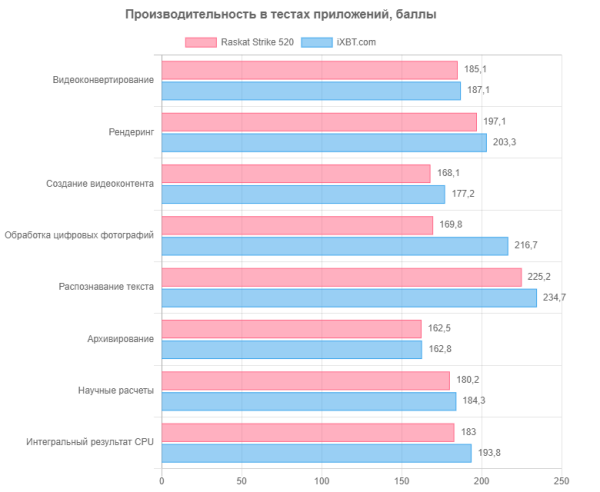
The only significant difference was noticed in the results of tests with photo processing. As mentioned earlier, these programs turn out to be little sensitive to the difference between “slow” DDR5 and “fast” DDR4 memory, especially in the case of Core i5 with energy-efficient cores. Perhaps the virtual four-channel DDR5 or the details of the memory controller implementation are affected. This discrepancy was also noted in tests with “pure” Core i5s, and the addition of energy-efficient cores only increased the difference. The Core i5-13400F, which is technically Alder Lake but on a higher-end silicon, will also be affected by this difference.
However, although there are significant differences in this group of tests, this does not lead to significant deviations in the overall results. The overall difference is only 5%, which, by the way, is even less than the difference in the maximum measured power consumption: 104 W on the reference test bench compared to 90 W in the Raskat Strike 520. So, although the processor on the more affordable board was weaker than it could on a more advanced system, this 5% difference turns out to be not so significant. Whether or not this difference is worth worrying about is up to the individual user to decide.
As for games, our test methodology is already outdated, and for a more accurate assessment of the performance of the Nvidia GeForce RTX 4070 Ti in modern games, it is better to refer to the corresponding reviews in the video card testing section. The WQHD performance of this graphics card and its usability for gaming at 4K settings are discussed in the related reviews.
| Game (maximum quality) | FHD | 4K |
|---|---|---|
| World of Tanks | 492/331 | 154/106 |
| World of Tanks (RT) | 392/270 | 129/86 |
| Far Cry 5 | 176/129 | 111/100 |
| Tom Clancy's Ghost Recon Wildlands | 133/117 | 62/54 |
| Metro: Exodus | 134/74 | 78/50 |
| Metro: Exodus (RT) | 130/71 | 60/40 |
| Shadow of the Tomb Raider | 172/118 | 101/86 |
| World War Z | 315/237 | 304/227 |
| Deus Ex: Mankind Divided | 172/126 | 81/47 |
| F1 2018 | 247/177 | 224/167 |
| Strange Brigade | 436/275 | 143/123 |
| Assassin's Creed Odyssey | 119/58 | 74/43 |
| Gears 5 | 221/150 | 102/68 |
The results speak for themselves: despite the increase in the power of video cards, increasing the resolution by four times can reduce performance so much that even the GeForce RTX 4070 Ti is not enough to smoothly play “old” projects in 4K at high frame rates. This explains the relatively low popularity of high-frequency 4K monitors among gamers, despite their relatively affordable price, which is sometimes several times less than the cost of such video cards.
Total
Highlight: Raskat Strike is a series of ready-made system units from a large component distributor. Configurations and component manufacturers can vary across different variants of this line, making it a flexible choice. The platform and video cards are also subject to change. Example of a product description: «System unit Raskat Strike 520 Intel Core i5 13400F (Intel Core i5-13400F 2.5 GHz), RAM 32 GB, SSD 2000 GB, NVIDIA GeForce RTX 4070 Ti 12 GB, Without OS, dark gray, black.» The closest analogue that we tested has a catalog price of about 180 thousand rubles, but thanks to discounts it can be purchased for 160 thousand. Are these systems worth their price? Let's consider approximately: a video card costs from 90 thousand, a processor — about 20, a motherboard — from 10 and above, an SSD adds at least another 20 thousand to the total cost, and so on. Thus, even under the best conditions, the cost of components is approximately equal to the price of the finished system.
Although the process of selecting and assembling a computer yourself is attractive to many, it can be inconvenient in places where the selection of components is limited or delivery times are long. Plus, when component problems occur, it's not always easy to find the source of the problem when you have a bunch of parts from different sources. In turn, ready-made systems sold through marketplaces offer convenience and quick assembly, as well as guaranteed testing before sale.
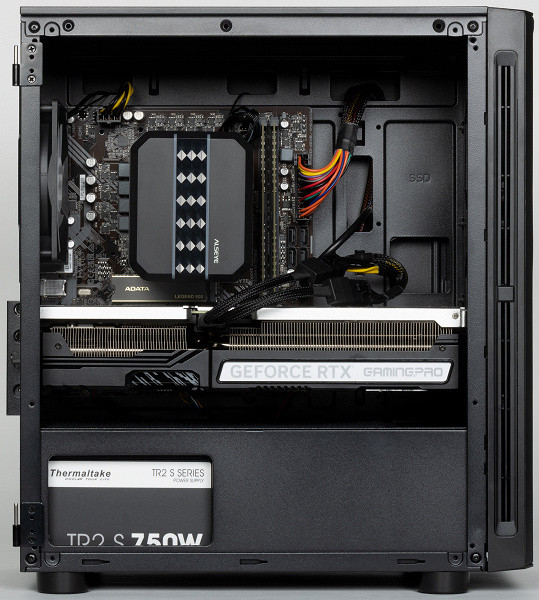
The conclusion can be formulated as follows: purchasing a gaming computer can be done in different ways, and each of them has its own advantages, suitable for different situations and consumer preferences. The Raskat Strike 520 is an example of a win-win concept where combining a Core i5 processor with a powerful graphics card allows you to create a powerful gaming PC without breaking the bank. This concept extends to other models in the range, offering an optimal balance between performance and price.
Although there is an option based on the Core i5-13600KF with DDR5-6000, the cost of this modification is higher, and in the context of its main purpose — gaming — it does not bring significant advantages. The main emphasis is on the video card, which determines the gaming performance of the system. For buyers who prefer pre-built systems and don't want to do the DIY, the Raskat Strike 520 is a good choice.
However, there are some suboptimal implementation details to note, such as the constant noise level from the four non-adjustable case fans. However, if the system is used exclusively for games, this problem may not be significant.
Overall, the Raskat Strike 520 is a specific solution for a specific application, available at a relatively low price, in fact corresponding to the cost of the components that make up the system. It's also worth noting the three-year warranty, which adds additional security.
